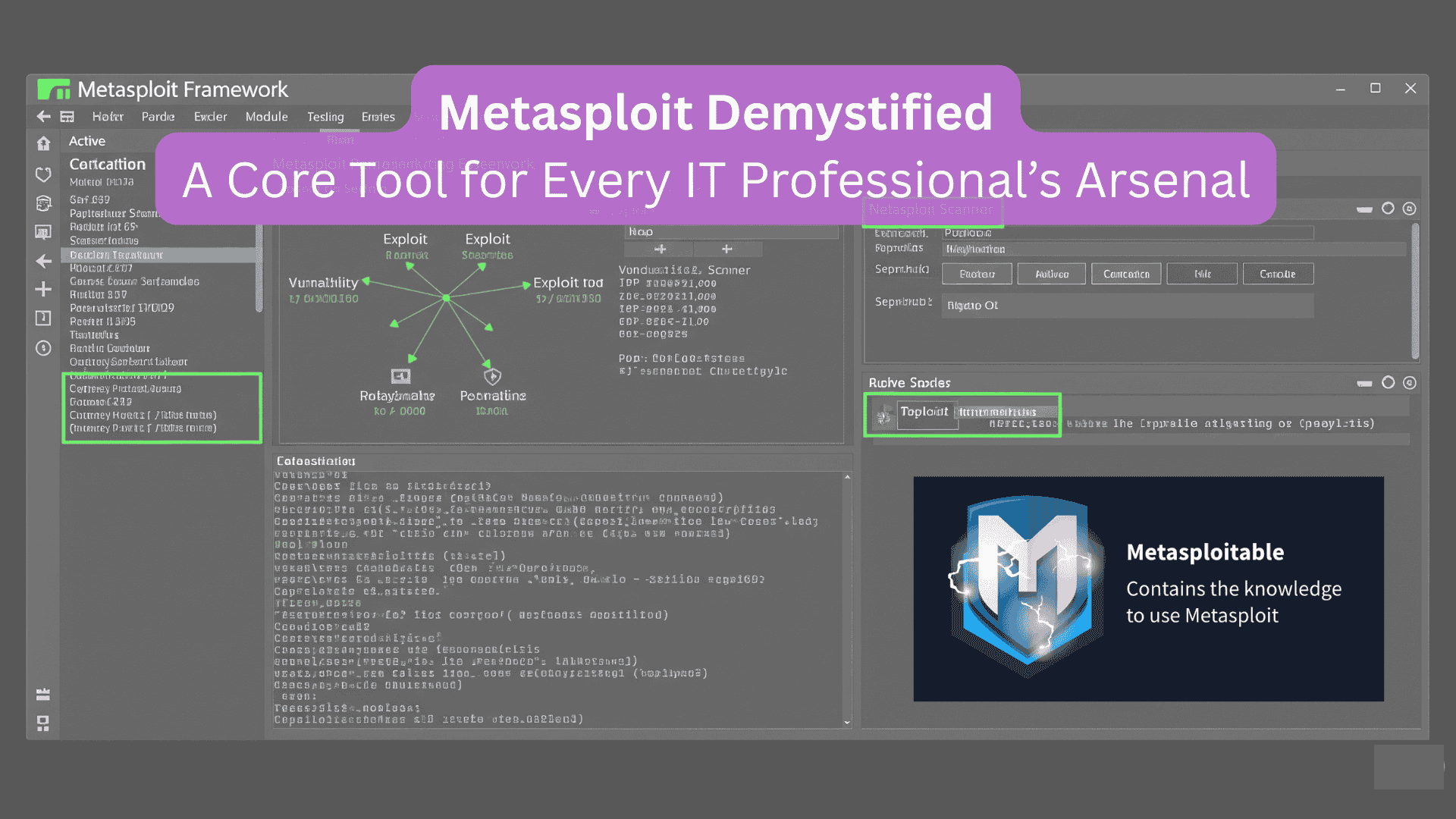Why Metasploit Matters to IT Professional
In today’s interconnected world, the threat landscape is a constantly shifting battleground. As an IT professional, you’re on the front lines, whether you’re managing servers, securing networks, or developing applications. It’s no longer enough to just react to security incidents; a proactive approach is paramount. This is where Metasploit comes into play.
Often misunderstood as solely a “hacker tool,” Metasploit is, in fact, a vital and versatile security validation platform. While it’s certainly used by ethical hackers and penetration testers, its capabilities extend far beyond. For system administrators, network engineers, developers, and even IT managers, understanding Metasploit offers invaluable insights into how attackers operate and, more importantly, how to build stronger, more resilient defenses.
This blog post will demystify Metasploit, breaking down its core components, exploring practical use cases for various IT roles, and providing you with resources to begin your hands-on journey.
What is Metasploit? The Fundamentals
At its heart, Metasploit is an open-source framework for developing, testing, and executing exploit code. Initially created in 2003, it has evolved into a comprehensive platform that aids in vulnerability research, penetration testing, and intrusion detection system (IDS) signature development.
Think of Metasploit as a specialized toolkit with several key components working in concert:
- Exploits: These are pieces of code designed to take advantage of specific vulnerabilities in a system or application. If a system has a known flaw, an exploit is the key that tries to unlock it.
- Payloads: Once an exploit successfully compromises a system, the payload is the code that runs on the target machine. This could be anything from gaining a shell (command-line access) to installing backdoors or stealing data.
- Auxiliary Modules: These modules don’t directly exploit vulnerabilities but are crucial for information gathering. They can perform scans, sniff network traffic, or check for specific service versions, helping you map out a target environment.
- Post-Exploitation Modules: After initial compromise, these modules help you maintain access, escalate privileges (gain higher levels of control), pivot to other systems, or collect more information from the compromised machine.
- Encoders & Nops: These are used to bypass security measures like antivirus software or intrusion prevention systems. Encoders transform payloads to make them less detectable, while Nops (No-Operation) sleds help ensure payloads execute correctly.
- Listeners: These are set up on your attacking machine to “catch” incoming connections from payloads executed on target systems, providing you with a channel to interact with the compromised host.
Metasploit in Action: Practical Use Cases for IT Professionals
Metasploit isn’t just for red teams; it’s a powerful tool that can significantly empower your daily IT operations and security posture.
A. Vulnerability Validation & Patch Management
How do you truly know if a patch fixed a vulnerability? Or if your shiny new intrusion prevention system (IPS) is effective? Metasploit allows you to:
- Verify Patch Effectiveness: After deploying a security patch, use Metasploit to attempt to exploit the previously vulnerable system. If the exploit fails, you have concrete proof the patch is working.
- Test Security Controls: Simulate real-world attacks against your own network to see if your firewalls, IDS/IPS, and other security controls detect or prevent them.
- Proactive Vulnerability Identification: Actively scan your network for known vulnerabilities before malicious actors find them.
B. Security Awareness & Training
One of the best ways to teach employees about cyber threats is to show them. Metasploit can be used responsibly to:
- Demonstrate Attack Vectors: Visually show staff how a phishing email with a malicious attachment could compromise a system.
- Simulate Phishing Attacks: (With proper authorization and ethical guidelines) create controlled phishing campaigns to test employee vigilance and identify areas for further training.
C. Network Defense & Hardening
Metasploit enables you to adopt an “attacker’s mindset” to fortify your defenses:
- Internal Penetration Testing: Regularly test your internal network for weak points, misconfigurations, and exploitable services that an insider threat or an attacker who gains initial access might leverage.
- Understand Attack Methodologies: By using the same tools attackers do, you gain a deeper understanding of their techniques, allowing you to anticipate and defend against them more effectively.
D. Incident Response (Forensics & Analysis)
While not a primary forensic tool, Metasploit can aid in understanding incidents:
- Recreate Attack Scenarios: After an incident, you can use Metasploit to try and recreate how an attacker might have gained access or moved through your network, helping you identify root causes and improve future defenses.
Practical Hands-On Learning Resources
Theory is great, but hands-on practice is where true understanding begins. I can attest to this personally: way back in April 2022, when I enrolled in the INE Security – eJPT course and aimed for the certification, I quickly realized Metasploit wasn’t just a part of the curriculum – it was central to it. Most of their course outline and the certification exam itself focused heavily on Metasploit; without a solid grasp of its functionalities, passing the exam would have been impossible.
To get you started and build that essential practical foundation, TryHackMe offers excellent, interactive rooms:
- Metasploit Introduction: This room will guide you through the fundamental concepts of Metasploit and help you get comfortable with the
msfconsole. - Metasploit Exploitation: This room focuses on the core process of finding, configuring, and executing exploits against vulnerable systems.
- Meterpreter Basics: Once you master basic exploitation, dive deeper into the powerful post-exploitation capabilities offered by the Meterpreter payload.
Achieve a badge like this one below by successfully finishing all three Metasploit rooms on TryHackMe.

Important Consideration: Always ensure you have explicit permission to test systems, whether they are in your own lab environment or production systems. Unauthorized access and exploitation are illegal and unethical.
Beyond the Basics: Advanced Concepts & Resources for Deeper Dive
Once you’re comfortable with the fundamentals, Metasploit offers a vast ocean of possibilities:
- Meterpreter: This is Metasploit’s advanced payload, providing a highly interactive shell that can load extensions, migrate processes, and perform a wide array of post-exploitation tasks without touching disk.
- Metasploit Pro vs. Metasploit Framework: While the open-source Metasploit Framework is free and powerful, Rapid7 offers Metasploit Pro, a commercial version with a GUI, automation features, and reporting capabilities for larger organizations.
- Integration with Other Tools: Metasploit plays well with other security tools like Nmap (for network scanning), Nessus or OpenVAS (for vulnerability scanning), and various social engineering toolkits.
Empowering Your IT Security Posture
Metasploit is far more than just an offensive tool; it’s an indispensable asset for any IT professional serious about security. By understanding how attackers think and the tools they use, you can proactively identify weaknesses, validate your defenses, and ultimately build a more secure environment.
Don’t be intimidated. Start with the basics, leverage the excellent hands-on resources available, and always practice ethically. Embracing Metasploit responsibly will undoubtedly empower your IT security posture and elevate your professional capabilities. Proactive security isn’t just a best practice; it’s your best defense.




